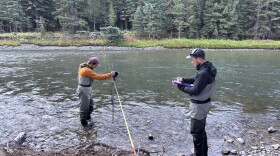-
A handful of federally funded "circuit riders" help Montana’s small towns keep their drinking water safe. Funding for the federal program that supports them lapsed during the government shutdown.
-
With winter approaching, a creek restoration project is wrapping up in the Bitterroot Mountains. Crossing the finish line was hard won. The project faced mounting challenges from federal funding cuts and layoffs. Uncertainty over federal support adds more hurdles for future improvements.
-
BLM continues oil and gas approvals despite federal shutdown; Environmental groups are petitioning the state to stop issuing pollution discharge permits until new standards can be set; The Montana State Prison has the green light to resume water use in all areas of the facility after a water line broke in October.
-
Drought experts say unpredictable precipitation patterns are making drought forecasts more difficult.
-
In 2023, the DEQ listed sections of the Gallatin River as impaired due to recurring algal blooms. The blooms choke out fish and degrade water quality. State scientists are amid a six-year study trying to understand what's causing the harmful blooms. The state says it will use the results to inform local development regulations and a plan to protect the river.
-
The U.S. Environmental Protection Agency has approved changes to how Montana determines water quality. A major water leak at the state prison in Deer Lodge has led to significant disruptions at the facility.
-
Big Sky Resort plans to use wastewater for making snow. Hemorrhagic disease may be killing deer in western Montana, FWP says. State releases resources on abuse and human trafficking education for teachers.
-
An aviation fuel company wants to inject wastewater into the ground along the Rocky Mountain Front. Federal officials say the plan wouldn’t put drinking water at risk. Residents are skeptical.
-
The Daily Inter Lake’s Jack Underhill is based in Kalispell and has been following the situation. He sat down with MTPR’s Elinor Smith to explain the timeline of discovery and how city officials handled the information.
-
A biofuels manufacturer in Great Falls announced plans to build a water treatment facility. This comes after the company previously proposed injecting the wastewater underground.
Play Live Radio
Next Up:
0:00
0:00
Available On Air Stations









